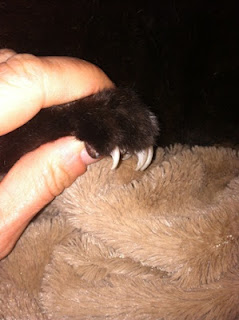Of all the things I faced as a new Vet the thing I thought might be the hardest on me to do was puppy dewclaws and tail docking.
I don't think of myself as being especially maternal but there is some internal switch that flips if I hear a puppy or kitten crying. (OK, throw onto that calf, lamb and piglet too). I had only seen tails and dewclaws at vet school done once before I went to work at a private vet practice. I remember when some client brought in her new litter of 6 handful sized puppies to the vet school. None of us knew why she brought them here? Didn't she have a "normal vet" she saw for the routine stuff?
Quickly a large mass of students, interns and residents gathered round to watch and cuddle. I was 1 student in a sea of 30 people, all eager to see "how it was done." Based on my rank, (bottom of the bucket), I had a nose bleed seat. Because of the rarity this event, there was only 1 person in the building that had ever actually done this procedure before. She was an intern who had spent 4 years working in private practice medicine before she "came back to school" at the vet school. She was, of course, unanimously elected to be the instructor to the group. The rest of us fought for holding duties.
It isn't that dewclaw removal is all that uncommon, it was that in this venue, a teaching hospital, it was a very very rare event. (At some point someone should tell the public you don't bring puppies to a university for such a simple mundane procedure).
I wasn't entering the real working world with a firm understanding as to how to do these. And the emotional weight of cutting off puppy tails seemed a very difficult task to bear.
Dewclaw removal and tail docking is recommended to be done on puppies between 3-5 days old. At this age they are stable from the stressful birthing process, able to stand some tiny bit of blood loss, and the cartilage and bone is still soft. The big disadvantage is that anesthesia and pain meds are not used. And then there is the whole crying baby trauma.
I had a client call me last week to report to me that her Rottweiler had just had her babies and she wanted me to arrange a time for the two puppies to have their dewclaws and tails done. I am always very grateful for an owner to alert me as soon as possible after the puppies have been born so we can arrange the procedure within the confines of puppy age and clinic appointments. For many reasons I need a big block of time to do tails and dewclaws. (There needs to be some puppy cuddling time, and I want to be super positive no one leaves bleeding, so we watch them for at least 20 minutes after, (more cuddling time)).
I have had owners call me and ask me to set up an appointment for them and when I asked "when the puppies were born?" I was told "4 months ago." I explained to her that she was pretty far outside of the very narrow window we had to perform this. I also reminded her that we were supposed to start vaccines at 8 weeks old, and that was assuming that mom was all up-to-date on her vaccines so that she was able to pass on her maternal antibodies to her babies to supply them with the first 8 weeks of immunity coverage. There is a TON of important information owners need to know BEFORE they breed their dog.
When we recommend 3-5 days after birth to do these procedures I remind clients there are ALWAYS exceptions to the rules. I am always a little reluctant and uneasy to supply exact dates, or weights, or numbers to medical procedures and recommendations because not every pup, dog, procedure, or treatment works the same for everyone.
The 2 Rottie puppies that I saw last week were one of the exceptions. These puppies were just 3 days old, but they were WHOPPERS! They were so big that we couldn't have waited 2 more days. I have also seen a Yorkie and a Sheltie that we waited a week to do because they were so small and puny.
For the new breeders I always suggest you talk to your vet before the whole delivery process. It is really helpful to have an x-ray at day 50 or so, (you have about 63 days between mating and delivery), to identify how many babies are expected to be delivered. Now I know this step sounds easy but I always say "I think I see..." and remind my clients that sometimes if there are many (like over 7) fetuses it can be hard to identify a small barely bony 3 dimension structure on a flat film. I have said "I think I see 7 or 8 babies" and had the dog deliver 11. But it is really nice to see 3 skeletons on an x-ray and then when the owner calls to say she only had 2 we know to re-check our x-ray, because there is probably 1 still in there.
Back to those 2 Rottie puppies.
I schedule tails and dewclaws for a quiet time of the day. I don't want to leave the puppies in the hospital or away from their mom for too long. I always speak to the owner about what she wants the tails to look like and make sure that she wants both the front and rear dewclaws removed. You want to be very clear about what you are doing and what the owners' expectations are. There are always breed standards that you can review (to see what length the tails are supposed to be), but some breeders like the tails on the short side and some on the long side. I often ask the breeder to bring mom along so we are both talking the same length, long for her might be short for me.
I have one very good friend who breeds Boxers. She was taught by her mentor to instruct the Vet to use a brand new nickel as the guide for tail length. She instructed me to place the nickel under the tail snug up to her butt and cut on the other side of the nickel. I was instructed to make "nickel length tails." Every time she needs her puppies done she brings me a brand new shiny nickel, that I "get to keep."
The owner for these two Rottie pups had to drop the puppies off and then had to run an errand while I removed their dewclaws and docked their tails. She also told the Receptionists that she "couldn't bear to be in the building and hear them cry." Because I didn't get to go over any of the specifics while she was here dropping off I called her.
I explained and confirmed what she wanted done and how the tails were to be done. "She said to me, "I will be praying for you, I know how hard this must be for you to do." I was a little taken back by her empathy for me. As much as we all complain and say a million "I'm sorry's" to the puppies as we hear them scream, no one has ever said sorry to me. I did confess to her that I didn't enjoy this procedure.
It is difficult to remove yourself enough from these babies to perform the task without feeling sad. And I do think tails and ears add much more personality to a pet. Nothing makes me happier than seeing my little Jekyl-pup wag his tail at me. Or watching those big ears flop in the wind as he runs.
Like every other surgery I perform I examine the patient pre-op, think about the entire procedure in my head before I ever reach for the scalpel and I go over from start to finish what needs to be done, what I am trying to accomplish, (like getting a cancer free tumor removal, or functionally part, etc), and I also think about what i hope the pet will look like post-op. If I can make the after result look great I always think of this before hand and aim for it. With puppies I want them to have no evidence of a scar and I want the tails to be healing quickly. I also want them to look as pretty as possible for the rest of their lives. I feel like I am practicing a little bit of plastic surgery.
I know that I am not supposed to be politically incorrect and I know that I will someday be reprimanded by my peers or the hard core AKC people, but I do think that de-clawing, tail docking and especially ear docking is a bit barbaric and old fashioned. I have been told that we are the only civilized country left in the world who still does these to pets.
I hope that one day I am only being asked to do cosmetic surgeries in the interest of patient well being. And they got lots and lots of cuddling!
The Rottie puppies did great, and their feet and tails healed beautifully and quickly just as I hoped they would.





















































